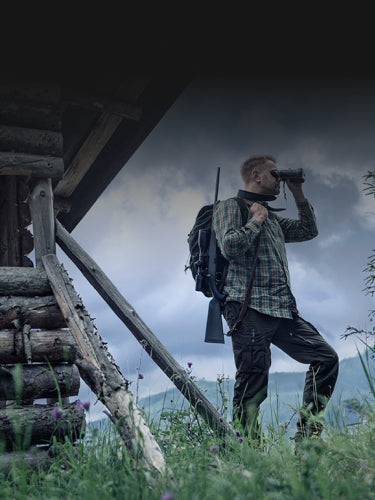Thermal vision technology has revolutionized hunting forever. Until relatively recently, a hunt was only as long as the light could last. But now, with the latest advancements in thermal night vision technology, hunters have the tools to effectively detect and identify their prey even in complete darkness. While the two words sound like synonyms, there is a very important difference in the world of thermal hunting.
In the simplest terms, detection refers to knowing whether an animal is in the area. A white dot spotted from a thousand yards away is considered to be “detected” but not identified. The hunter recognizes it to be a living thing but has no idea whether it’s a wild hog or a domestic cow. At that distance, a white dot could be anything, and no responsible hunter should take the shot even if he knows he’s capable of doing so.

This mystery animal in this rendering is "detected" but unidentified thanks to the thermal bloom and distance of the target.
Identification, by contrast, is having a clear understanding of what you’re shooting at. If you recognize that something has four legs and a tail but can’t tell if it’s a deer or a horse, you have failed to identify your target. Identification is important for making clear shots on well defined targets and helps hunters avoid the serious legal repercussions which may follow shooting at the wrong thing.
With advancements such as the Thermion 2 LRF XL50, hunters can now benefit from extended detection ranges and improved image quality. Now, more than ever, the ability to see in the dark must be paired with strong visual identification systems to ensure regulations are followed and the right animals are harvested.

This raccoon is detected and easily identified at a long range thanks to high quality Pulsar sensors.
Maximizing Detection and Identification Ranges:
Pulsar recognizes the need for image quality in night hunting and has presented the Thermion 2 LRF XL50 as one of its many solutions. The Thermion 2 LRF XL50 is a cutting-edge thermal imaging device that provides hunters with a maximum detection range of 2515 yards, allowing for early detection of game animals at substantial ranges while providing a significant advantage in tracking their movements. Indeed, its maximum identification range extends up to approximately 300 yards, enabling hunters to discern vital details necessary for accurate targeting.
Understanding Animal Behavior:
To effectively utilize thermal vision, hunters must possess knowledge of animal behavior. For instance, a large group of fast-moving animals seen charging through a large field is typically a sounder of wild hogs. Conversely, animals such as coyotes are usually solitary, except during mating season and deer crane their heads and look like miniature giraffes.
Recognizing this behavior can help hunters identify certain species like wild boars, which often travel in groups. This understanding enables hunters to make informed decisions based on the behavior patterns exhibited by different game animals.
This is important because instances have been reported where dogs, such as huskies and malamutes, have been mistaken for coyotes when viewed through thermal imaging. To mitigate such risks, the Thermion 2 LRF XL50 utilizes a highly sensitive 1024x768 sensor, ensuring crisp and detailed images with excellent contrast. This feature provides hunters with the necessary clarity to confidently differentiate between animals, enhancing safety and ethical hunting practices.
Calling techniques can be employed to bring game animals closer, facilitating clearer shots. If an unfamiliar shape is detected on thermal imaging at a long distance, it is advised not to engage the target immediately. Instead, hunters can use appropriate calls based on the size of the animal's group and its particular gait to attract them closer, allowing for better visual confirmation and identification. This strategy enhances accuracy and reduces the risk of misidentifying targets.
While thermal vision technology offers the advantage of detecting and identifying game animals at night, it is important to adhere to regulations and exercise caution. Shooting deer at night is generally ill-advised, especially if it is 30 minutes after sunset and on public property. However, there are specific conditions and permissions for hunting deer at night on private property. It is crucial for hunters to familiarize themselves with local regulations to ensure they are hunting responsibly and legally.
Understanding Local Regulations:
When engaging in thermal vision hunting, it is essential to be aware of local regulations. Night vision scopes, while effective at short-range identification, may emit infrared (IR) light, making them illegal to use in some states. However, thermal vision devices do not emit IR light, making them a permissible option in such areas. Hunters must always check their local state regulations to ensure compliance and avoid any legal issues.
Thermal vision technology has significantly advanced the capabilities of hunters, enabling them to detect and identify game animals with increased precision and accuracy, even in low-light conditions. The Thermion 2 LRF XL50, with its extended detection range, superior image quality, and adherence to local regulations, provides hunters with an invaluable tool for successful and safe hunting experiences. By understanding animal behavior, utilizing calling techniques, and prioritizing image quality, hunters can optimize their effectiveness while ensuring ethical and responsible hunting practices.
If our products have helped you in any way, share your story with us! Accepted stories will receive a 20% discount code.





